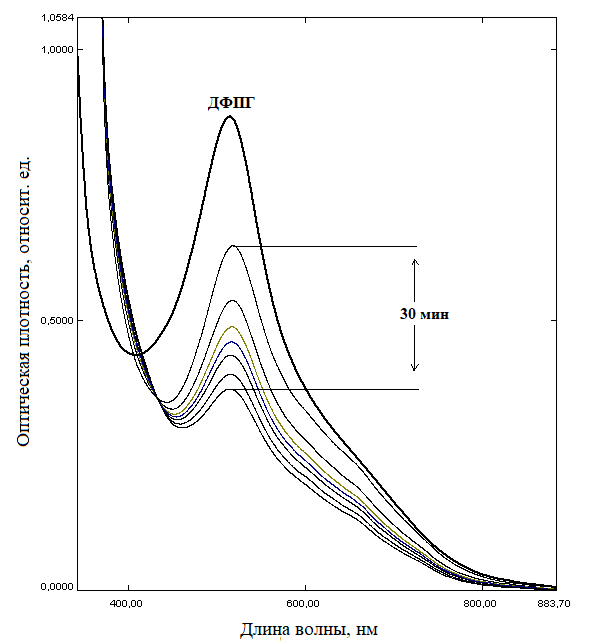ANTIRADICAL ACTIVITY OF EXTRACTIVES FROM THE ACHILLEA MILLEFOLIUM L. OF THE SIBERIAN REGION
UDC 547.19
Abstract
In model reactions with a free stable 2,2-diphenyl-1-picrylhydrazyl radical, the antiradical properties of extractives of common yarrow (Achillea millefolium L.) growing in the Krasnoyarsk Territory were studied: water-alcohol extracts with an alcohol content of 20, 40 and 70% and essential oil. Whole essential oil is obtained by exhaustive hydro-steam distillation for 11 hours. In addition, separate oil fractions were obtained: the first after 20 minutes from the start of distillation, the second after the next 50 minutes, the third after the next 180 minutes, and the fourth after the next 360 minutes.
The results of the DPPH test showed that ARA is minimal for alcohol-soluble substances and increases for aqueous-alcoholic extracts from 20.3% in the case of a 20% extract to 21.8% for a 70% aqueous-alcoholic extract. ARA of the obtained samples of essential oil surpasses the ARA values of aqueous, alcoholic and aqueous-alcoholic extracts. It was found that the APA value for 1 fraction of oil is 29.7% and increases with the transition to subsequent fractions to 54.3%. Whole Yarrow essential oil has an ARA value of 52.8%.
According to the ARA value, the extractives of yarrow can be arranged in the following row: whole essential oils> 70% aqueous-alcoholic extract> 40% extract> 20% extract> aqueous extract> 96% alcoholic extract.
Downloads
Metrics
References
Kutsik R.V., Zuzuk B.M. Provizor, 2002, no. 14, URL: http://provisor.com.ua/archive/2002/N14/art_28.php?part_code=68&art_code=3220. (in Russ.).
Kutsik R.V., Zuzuk B.M. Provizor, 2002, no. 15. URL: http://provisor.com.ua/release.php?code=200215. (in Russ.).
Candana F., Unlub M., Tepec B., Dafererad D., Polissioud M., Sökmenc A., Akpulat H.A. Journal of Ethnopharma-cology, 2003, vol. 87, pp. 215–220. DOI: 10.1016/S0378-8741(03)00149-1.
Vitalini S., Beretta G., Iriti M., Orsenigo S., Basilico N., Acqua S., Iorizzi M., Fico G. Biochimica Polonica, 2011, vol. 58, no. 2, pp. 203–209. DOI: 10.18388/ABP.2011_2266.
Buleandra M., Moldovan Z., Badea I.A., David I.G., Popa D.E., Orrea E., Caglar T.A., Basaga S.H. Rev. Chim., 2020, vol. 71, no. 3, pp. 69–78. DOI: 10.21603/2308-4057-2020-1-125-133.
Daniel P.S., Lourenco E.LB., Cruz R.M.S., Goncalves C.H.S., Almas L.R.M., Silva J.H.C., Jacomassi E., Junior L.B., Alberton O. Australian Journal of Crop Science, 2020, vol. 14, no. 3, pp. 545–550.
Ushanova V.M., Voronin V.M., Repyakh S.M. Khimiya rastitel'nogo syr'ya, 2001, no. 3, pp. 105–110. (in Russ.).
GOST 24027-2-80. Fiziko-khimicheskiye pokazateli: vlazhnost', zola, ekstraktivnyye veshchestva, efirnyye masla. [GOST 24027-2-80. Physical and chemical indicators: moisture, ash, extractives, essential oils]. Moscow, 1982, 25 p. (in Russ.).
GOST 24556-89. Produkty pererabotki plodov i ovoshchey. Metody opredeleniya vitamina C. [GOST 24556-89. By-products of fruits and vegetables. Methods for determining vitamin C]. Moscow, 1990, 13 p. (in Russ.).
Trineva O.V., Slivkin A.I., Voropayeva S.S. Vestnik VGU. Seriya: Khimiya, Biologiya, Farmatsiya, 2013, no. 2, pp. 215–219. (in Russ.).
Bazarnova Yu.G. Voprosy pitaniya, 2006, no. 1, pp. 41–45 (in Russ.).
Kuznetsova I.V. Khimiya rastitel'nogo syr'ya, 2015, no. 4, pp. 57–61. (in Russ.).
Gosudarstvennaya farmakopeya SSSR. [State Pharmacopoeia of the USSR]. Moscow, 1968, 1081 p. (in Russ.).
Dere S., Gunes Т. Turkish journal of Botany, 1998, vol. 22, pp. 13–17.
Yefremov A.A. Uspekhi sovremennogo yestestvoznaniya, 2013, no. 7, pp. 88–94. (in Russ.).
Tkachev A.V. Issledovaniye letuchikh veshchestv rasteniy. [Study of plant volatiles]. Novosibirsk, 2008, 969 p. (in Russ.).
Alyakin A.A., Yefremov A.A., Kachin S.V., Strukova Ye.G. Khimiya rastitel'nogo syr'ya, 2009, no. 4, pp. 51–56. (in Russ.).
Molyneux P. Songklanakarin J. Sci.Technol., 2004, vol. 26, no. 2, pp. 211–219.
Kalinkina A.D., Dembitskiy T.P., Berezovskaya A.A. Khimiya rastitel'nogo syr'ya, 2000, no. 3, pp. 13–18. (in Russ.).

Copyright (c) 2021 chemistry of plant raw material

This work is licensed under a Creative Commons Attribution 4.0 International License.

This work is licensed under a Creative Commons Attribution 4.0 International License.
The authors, which are published in this journal, agree to the following conditions:
1. Authors retain the copyright to the work and transfer to the journal the right of the first publication along with the work, at the same time licensing it under the terms of the Creative Commons Attribution License, which allows others to distribute this work with the obligatory indication of the authorship of this work and a link to the original publication in this journal .
2. The authors retain the right to enter into separate, additional contractual agreements for the non-exclusive distribution of the version of the work published by this journal (for example, to place it in the university depository or to publish it in a book), with reference to the original publication in this journal.
3. Authors are allowed to post their work on the Internet (for example, in a university repository or on their personal website) before and during the review process of this journal, as this may lead to a productive discussion, as well as more links to this published work.











